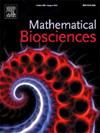The roles of continuous and discontinuous proliferations on hepatitis B virus infection
IF 1.8
4区 数学
Q2 BIOLOGY
引用次数: 0
Abstract
The proliferation of both uninfected and infected hepatocytes, as well as the recycling effects of rcDNA-containing capsids are two key mechanisms playing significant roles in the persistence and clearance of hepatitis B virus (HBV) infection. In this study, the temporal dynamics of this viral infection is investigated through two intercellular mathematical models considering proliferation of both types of hepatocytes (uninfected and infected) and recycling effects of capsids. Both models are formulated on the basis of a key finding in the existing literature: mitosis of an infected hepatocytes yields in two uninfected progenies. In the first model (defined by P-model), we examine the continuous proliferation (which occur continuously), while the second one (defined by M-model) deals with the discontinuous proliferation (happen when the concentration of liver cells decreases to less than 70% of its initial concentration). The proposed models are calibrated with the experimental data obtained from an adult chimpanzee. Results of this study suggest that when both hepatocytes proliferate with equal rate, proliferation helps the individual in a rapid recovery from the acute infection whereas in case of chronic infection, the severity of the infection increases. On the other hand, if the infected hepatocytes proliferate at a different rate that of uninfected hepatocytes, the proliferation of uninfected hepatocytes contributes to increase the infection, but the proliferation of infected hepatocytes acts to reduce the infection from the long-term perspective. The global sensitivity analysis also shows the same results. Furthermore, it is also observed that the differences between the outcomes of continuous and discontinuous proliferations are significant and noteworthy.
乙型肝炎病毒连续和不连续增殖在感染中的作用
未感染和感染肝细胞的增殖以及含rcdna衣壳的循环作用是乙肝病毒(HBV)感染持续和清除中发挥重要作用的两个关键机制。在这项研究中,通过考虑两种类型的肝细胞(未感染和感染)增殖和衣壳再循环效应的两个细胞间数学模型研究了这种病毒感染的时间动力学。这两个模型都是根据现有文献中的一个关键发现制定的:感染肝细胞的有丝分裂在两个未感染的后代中产生。在第一个模型(定义为p模型)中,我们研究连续增殖(连续发生),而第二个模型(定义为m模型)研究不连续增殖(发生在肝细胞浓度下降到初始浓度的70%以下时)。所提出的模型是用从一只成年黑猩猩身上获得的实验数据来校准的。本研究结果表明,当两种肝细胞以相同的速度增殖时,增殖有助于个体从急性感染中快速恢复,而在慢性感染的情况下,感染的严重程度会增加。另一方面,如果感染肝细胞的增殖速度不同于未感染肝细胞,则未感染肝细胞的增殖有助于增加感染,但从长远来看,感染肝细胞的增殖有助于减少感染。全局敏感性分析也显示了相同的结果。此外,还观察到连续和不连续增殖的结果之间的差异是显著和值得注意的。
本文章由计算机程序翻译,如有差异,请以英文原文为准。
求助全文
约1分钟内获得全文
求助全文
来源期刊

Mathematical Biosciences
生物-生物学
CiteScore
7.50
自引率
2.30%
发文量
67
审稿时长
18 days
期刊介绍:
Mathematical Biosciences publishes work providing new concepts or new understanding of biological systems using mathematical models, or methodological articles likely to find application to multiple biological systems. Papers are expected to present a major research finding of broad significance for the biological sciences, or mathematical biology. Mathematical Biosciences welcomes original research articles, letters, reviews and perspectives.
 求助内容:
求助内容: 应助结果提醒方式:
应助结果提醒方式:


